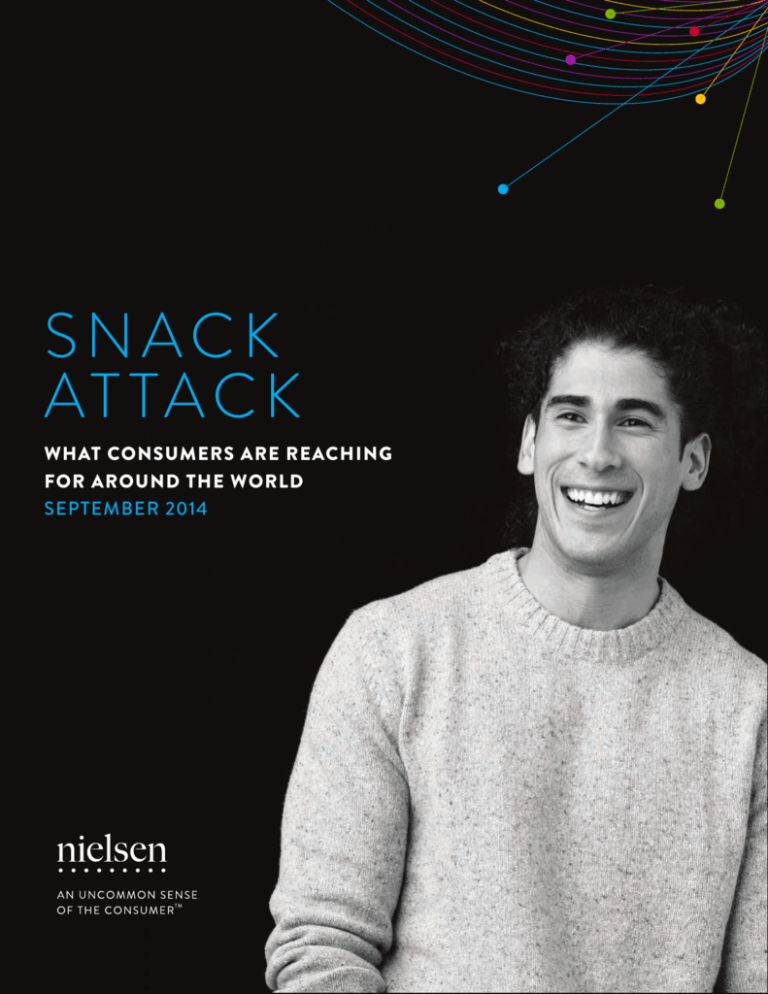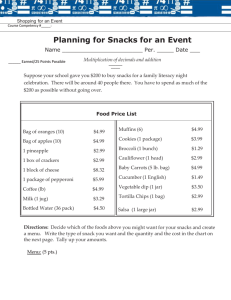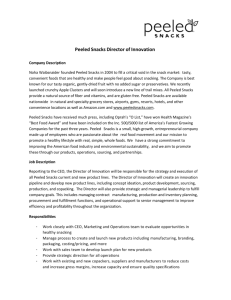
SNACK
AT TA C K
WHAT CONSUMERS ARE REACHING
FOR AROUND THE WORLD
SEPTEMBER 2014
Copyright © 2014 The Nielsen Company
1
UNDERSTAND THE
WHY BEFORE THE
BUY OF SNACKING
AROUND THE WORLD
Snack sales totaled $374 billion annually ending March 2014—
an increase of 2%* year-over-year
Annual snack sales grew more than two times faster
in developing regions
Snacks as meal replacements are a growing opportunity
Women consume more snacks than men
Consumers want snacks to stick with the basics; the absence
of ingredients is more important than the addition of them
WHO DOESN’T LOVE A GOOD SNACK?
Always at the ready, those crispy, crunchy, chewy provisions are our
comfort food when we are down, meal replacement when we are in a
hurry, companion when we are relaxing and party staple when we are
celebrating. These indulgent products, however, often get a bad rap as
they shoulder some of the blame for eating habits that can contribute to
health issues.
As snack manufacturers look to tailor offerings to deliver snacks
that appeal to both the palate and the psyche, knowing what drives
a consumer to pick one snack rather than another is vital to stay
competitive in the $374 billion worldwide snacking industry.
*Adjusted for inflation.
2
SNACK ATTACK
So what’s the go-to nosh for consumers craving a snack—salty, savory,
sweet or spicy? How much are health considerations taken into account
when selecting a snack? As the size of category sales and consumer
need-states across the worldwide snacking industry vary widely from
region to region and country to country, finding growth opportunities
requires both a global and local understanding of what consumers say
and do—which are not always the same.
“The competitive landscape in the snacking industry is fierce,” said
Susan Dunn, executive vice president, Global Professional Services,
Nielsen. “Demand is driven primarily by taste and health considerations
and consumers are not willing to compromise on either. The right
balance is ultimately decided by the consumer at the point of purchase.
Understanding the why before the buy provides the foresight necessary
to deliver the right product to the right consumer at the right time.”
The Nielsen Global Snacking Survey polled 30,000 online consumers
in 60 countries to identify which snacks are most popular around the
world and which health, taste and texture attributes are most important
in the selection criteria. We take an in-depth look at the reasons why
we consume snacks, and we offer insights and recommendations
for expansion opportunities that will help manufacturers better align
offerings to consumer needs and desires.
ABOUT THE GLOBAL SURVEY METHODOLOGY
The findings in this survey are based on respondents with
online access in 60 countries. While an online survey
methodology allows for tremendous scale and global reach, it
provides a perspective only on the habits of existing Internet
users, not total populations. In developing markets where
online penetration is still growing, audiences may be younger
and more affluent than the general population of that country.
In addition, survey responses are based on claimed behavior
rather than actual metered data.
Where noted, the survey research is supplemented with actual
behavior using Nielsen’s retail and consumer purchase data.
Copyright © 2014 The Nielsen Company
3
SIZE OF THE
OPPORTUNIT Y
SNACKS ARE MORE THAN JUST TAST Y TREATS;
THEY’RE ALSO BIG BUSINESS.
Global snack sales totaled $374 billion annually ending March 2014—an
increase of 2%* year-over-year, according to Nielsen retail sales data.
Europe ($167 billion) and North America ($124 billion) make up the
majority of worldwide snack sales, with sales flat in Europe, and growing
at a rate of 2% in North America, compared to the previous year. While
annual snack sales in Asia-Pacific ($46 billion), Latin America ($30
billion) and the Middle East/Africa ($7 billion) are significantly lower
than in the other two regions, annual growth in these largely developing
regions increased more over the past year—4% in Asia-Pacific, 9% in
Latin America and 5% in the Middle East/Africa.
So what types of snacks are driving sales around the world? It depends
on where you live.
Confections—which include sugary sweets, such as chocolate, hard
candy and gum—comprise the biggest sales contribution to the overall
snack category in Europe ($46.5 billion) and the Middle East/Africa ($1.9
billion). Salty snacks contribute more than one-fifth of snack sales in
North America ($27.7 billion), refrigerated snacks comprise almost onethird of snacks in Asia-Pacific ($13.7 billion) and cookies and snack cakes
make up more than one-fourth of total snacks in Latin America ($8.6
billion).
NON-SUGARY
SNACKS ARE
SHOWING
STRONG
GROWTH
Smaller in size but big in potential: the fastest-growing snack categories
are ones to watch. Sales of savory snacks, which include crackers, rice
cakes and pita chips, increased 21% in the last year in Latin America.
Meat snacks, which include jerky and dried meat, grew 25% in the
Middle East/Africa and 15% in North America. Refrigerated snacks,
which include yogurt, cheese snacks and pudding, jumped 6.4% in AsiaPacific, while dips and spreads, which include salsa and hummus, rose
6.8% in Europe.
“Non-sugary snacks closely aligned with meal-replacement foods are
showing strong growth, which signals a shift in a consumer mindset to
one focused on health,” said Dunn. “While conventional cookies, cakes
and confections categories still hold the majority share of snack sales,
more innovation in the healthy snacking and portable food space is
necessary to adjust to this changing dynamic.”
*Adjusted for inflation.
4
SNACK ATTACK
THE BIGGEST SNACK CATEGORIES WORLDWIDE
RETAIL ANNUAL DOLL AR SALES ENDING MARCH 2014
NORTH AMERICA
EUROPE
$124B SALES (+2% CHG. vs. YA)
$28B
SALTY
REFRIGERATED
$20B
VEGETABLES/FRUIT
$47B
CONFECTIONS
REFRIGERATED
$22B
CONFECTIONS
$167B SALES (NO CHG VS. YA)
$36B
SALTY
$17B
$24B
COOKIES/CAKES
ASIA-PACIFIC
$22B
$46B SALES (+4% CHG. vs. YA)
REFRIGERATED
$14B
$12B
COOKIES/CAKES
CONFECTIONS
SALTY
LATIN AMERICA
$9B
CONFECTIONS
$8B
SALTY
REFRIGERATED
$7B
$5B
$9B
MIDDLE EAST/AFRICA
$30B SALES (+9% CHG. vs. YA)
COOKIES/CAKES
$11B
$7B SALES (+5% CHG. vs. YA)
$2B
CONFECTIONS
$2B
SALTY
COOKIES/CAKES
$1B
REFRIGERATED
$1B
Source: Nielsen Retail Sales, 52 weeks ending March 2014, adjusted for inflation
Copyright © 2014 The Nielsen Company
5
FRESH FRUIT
IS BEST, BUT
CHOCOL ATE IS
SWEET
We asked consumers around the world what one snack they would
choose above all others. The overwhelming answer: Fresh fruit. But
chocolate is a close second.
Across the regions, and by large margins, global respondents say that
fresh fruit (18%) is the snack of choice selected from a list of 47 different
snacking options, followed by chocolate (15%). Both snack categories
scored more than double or triple the responses for yogurt (6%), bread/
sandwiches (6%), cheese (5%), potato chips/tortilla chips/crisps (5%),
vegetables (5%) and ice cream/gelato (4%). Still, as the low percentages
suggest, consumers’ preferences vary widely when it comes to picking a
favorite.
Choosing just one snack is hard, which is why consumers don’t. They
want variety.
In the span of 30 days, at least half of global respondents say they ate
chocolate (64%), fresh fruit (62%), vegetables (52%), cookies/biscuits
(51%), bread/sandwich (50%) and yogurt (50%). More than four in
10 respondents consumed cheese (46%), potato chips/tortilla chips/
crisps (44%) and nuts/seeds (41%). One-third chewed gum (33%) and
devoured ice cream/gelato (33%), while about one-fourth munched on
popcorn (29%), crackers/crisp breads (28%) and cereal (27%). Softer
offerings like dumplings (26%) and instant noodles (26%) were also
popular with a quarter of respondents.
Taste preferences for snack options are noticeably different around
the world. Besides fresh fruit and chocolate, large percentages of
respondents also snack on vegetables in Asia-Pacific (57%), cheese in
Europe (58%), bread/sandwiches in the Middle East/Africa (47%), ice
cream/gelato in Latin America (63%) and potato chips/tortilla chips in
North America (63%).
6
SNACK ATTACK
“In the dichotomy of snacking, consumers want healthy, but yet
indulgent options are still going strong,” said Dunn. “A better
understanding of consumer demand and the need states that drive
demographic profile preferences will help manufacturers crack the code
on the right portfolio balance between indulgence and healthy. It will
also increase the odds of success in this ultra-competitive landscape.”
Snacking differences between the sexes is also prevalent. Globally,
women drive snacking consumption more than men. More women
consume chocolate (68% women vs. 61% men), fresh fruit (68% vs.
57%), vegetables (56% vs. 49%), cookies/biscuits (55% vs. 48%), bread/
sandwiches (51% vs. 49%), yogurt (57% vs. 44%), cheese (51% vs. 41%),
potato chips/tortilla chips (45% vs. 42%), nuts/seeds (44% vs. 39%)
and gum (34% vs. 32%).
Copyright © 2014 The Nielsen Company
7
TOP 10 FAVORITE SNACKS BY REGION
PERCENTAGE OF CONSUMERS WHO SAID THEY ATE THESE
SNACKS IN THE L AST 30 DAYS
GLOBAL AVERAGE
1. CHOCOLATE
ASIA-PACIFIC
CHOCOLATE
69%
FRESH FRUIT
65%
VEGETABLES
57%
COOKIES/BISCUITS
55%
BREAD/SANDWICH
54%
NUTS/SEEDS
49%
YOGURT
48%
CHIPS/CRISPS
43%
DUMPLINGS
43%
GUM
38%
64%
2. FRESH FRUIT
62%
3. VEGETABLES
52%
4. COOKIES/ BISCUITS
51%
5. BREAD/ SANDWICH
50%
FRESH FRUIT
62%
CHOCOLATE
61%
6. YOGURT
50%
CHEESE
58%
YOGURT
54%
7. CHEESE
46%
VEGETABLES
49%
8. CHIPS/CRISPS
44%
COOKIES/BISCUITS
45%
9. NUTS/ SEEDS
41%
10. GUM/ICE CREAM
33%
MIDDLE EAST/AFRICA
LATIN AMERICA
EUROPE
BREAD/SANDWICH
42%
CHIPS/CRISPS
38%
NUTS/SEEDS
34%
GUM
31%
NORTH AMERICA
FRESH FRUIT
52%
YOGURT
66%
CHIPS/CRISPS
63%
CHOCOLATE
51%
CHOCOLATE
64%
CHOCOLATE
59%
BREAD/SANDWICH
47%
CHEESE
64%
CHEESE
58%
CHIPS/CRISPS
43%
ICE CREAM/GELATO
63%
COOKIES/BISCUITS
56%
CHEESE
42%
FRESH FRUIT
57%
FRESH FRUIT
55%
YOGURT
41%
BREAD/ SANDWICH
55%
BREAD/ SANDWICH
48%
COOKIES/BISCUITS
41%
VEGETABLES
50%
CRACKERS/CRISPBREADS 48%
VEGETABLES
39%
POPCORN
49%
VEGETABLES
44%
ICE CREAM/GELATO
33%
CRACKERS/CRISPBREADS 45%
PEANUT BUTTER
44%
POPCORN
26%
COOKIES/BISCUITS
POPCORN
43%
44%
Source: Nielsen Global Snacking Survey, Q1 2014
8
SNACK ATTACK
SNACKING WITH A
CONSCIENCE
When reaching for a snack, how much do you think about the
ingredients inside? Are attributes such as artificial coloring, natural
flavors and high fructose corn syrup important criteria in the decisionmaking process? What about snacks that contain whole grain, protein
and fiber?
It turns out that more respondents around the world care about the
absence of ingredients than the addition of them. “Consumers want
snacks to stick to the basics,” said Dunn.
Snacks with all natural ingredients are rated very important by 45% of
global respondents and moderately important by 32%—the highest
percentages out of the 20 health attributes included in the study. The
absence of artificial colors (44%), genetically modified organisms
(43%) and artificial flavors (42%) are also rated very important when it
comes to the snacks we eat. Caffeine-free (23%) and gluten-free (19%)
snacks are very important for about one-fourth and one-fifth of global
respondents, respectively.
Less is more for roughly one-third of global respondents who think it’s
very important that snacks be low in sugar (34%), salt (34%), fat (32%)
and calories (30%). One-fourth of those surveyed want snacks that have
either low or no carbohydrates. Conversely, roughly one-third are looking
for beneficial ingredients, rating fiber (37%), protein (31%) and whole
grains (29%) as very important attributes in the snacks they eat.
CONSUMERS
WANT SNACKS
TO STICK TO
THE BASICS
Environmentally conscious consumers believe it is very important that
snacks include ingredients that are sourced sustainably (35%), are
organic (34%) and use local herbs (25%).
Meanwhile, portion control is very important for just over one-fourth of
global respondents (27%).
Copyright © 2014 The Nielsen Company
9
BACK-TO-BASICS SNACK ATTRIBUTES MATTER MOST
PERCENTAGE THAT RATE HEALTH ATTRIBUTES VERY,
MODERATELY OR SLIGHTLY IMPORTANT
VERY
IMPORTANT
BACKTO-BASICS
LESS
IS MORE
MORE
IS MORE
SUSTAINABLE
MODERATELY
IMPORTANT
SLIGHTLY
IMPORTANT
ALL NATURAL
45%
NO ARTIFICIAL COLORS
44%
31%
GMO FREE
43%
30%
NO ARTIFICIAL FLAVORS
42%
NATURAL FLAVORS
37%
CAFFEINE FREE
23%
GLUTEN FREE
19%
LOW SALT/SODIUM
34%
37%
19%
LOW SUGAR/SUGAR FREE
34%
37%
19%
LOW FAT
32%
LOW CALORIES
30%
PORTION CONTROL
27%
39%
NO HIGH FRUCTOSE CORN SYRUP
26%
37%
LOW/NO CARBOHYDRATES
25%
WHOLE GRAIN
29%
HIGH IN PROTEIN
31%
HIGH IN FIBER
37%
INGREDIENTS SOURCED
SUSTAINABLY/FAIR TRADE
35%
34%
19%
ORGANIC
34%
35%
20%
LOCAL HERBS/INGREDIENTS
25%
32%
15%
15%
16%
33%
16%
38%
32%
17%
25%
32%
26%
36%
21%
37%
21%
23%
23%
39%
23%
37%
21%
37%
20%
37%
35%
17%
25%
Source: Nielsen Global Snacking Survey, Q1 2014
10
SNACK ATTACK
WHY WE SNACK
Just as no two people are alike, the reasons why we snack are diverse
and varied. But there are some common themes.
The obvious reason we snack is for pure enjoyment. We snack because
it tastes good and the experience is pleasurable. But snacks that are
focused on just enjoyment are missing some key opportunities—today’s
consumers expect snacks to serve many needs.
For instance, more than three-quarters of global respondents (76%) eat
snacks often or sometimes to satisfy their hunger between meals or to
satisfy a craving, but fewer (45%) global respondents consume snacks
as a meal alternative—52% for breakfast, 43% for lunch and 40% for
dinner. Middle East/Africa (58%) and Latin America (55%) respondents
exceed the global average for eating snacks as a replacement meal.
“There is a perception that snacks are intended more for in-between
meals than for actual meal replacements,” said Dunn. “But busy, onthe-go lifestyles often dictate a need for quick meals, and many opt for
fast food options that can be high in calories and low in health benefits.
There is a massive untapped opportunity to gain market share in the
nutritious, portable and easy-to-eat meal alternative market that snack
manufacturers could fill.”
Nutrition is the reason why 63% of global respondents eat snacks, and
61% snack to get an energy boost. Many also consume snacks when
taking a break (60%) and when passing the time (53%). Therefore,
it’s reasonable to believe that given a snack option that fills a need
for nourishment, many consumers will pick an option that is both
convenient and nutritious.
THERE IS AN
OPPORTUNITY
TO GAIN MARKET
SHARE IN THE
NUTRITIOUS,
PORTABLE MEAL
ALTERNATIVE
MARKET
Other reasons for snacking are purely emotional. Sixty-four percent of
global respondents eat snacks to improve their mood, 53% as a reward
and 44% because they are stressed. Only 38% consume snacks often or
sometimes to manage their weight.
Copyright © 2014 The Nielsen Company
11
OPPORTUNIT Y GAP BETWEEN SNACKING FOR HUNGER
AND FOR MEAL REPL ACEMENT
THINKING ABOUT THE SNACKS YOU ATE IN THE L AST 30 DAYS,
WHY DID YOU CONSUME THESE SNACKS?
HUNGER
77%
79%
MEAL REPLACEMENT
63%
55%
39%
37%
44%
41%
37%
64%
62%
57%
56%
63%
58%
50%
56%
48%
51%
ASIAPACIFIC
69%
66%
60%
EUROPE
75%
66%
MIDDLE
EAST/
AFRICA
74%
80%
LATIN
AMERICA
84%
83%
66%
NORTH
AMERICA
SATISFY HUNGER
BETWEEN MEALS
SATISFY
A CRAVING
PROVIDE
NUTRITION
BREAKFAST
41%
LUNCH
DINNER
Source: Nielsen Global Snacking Survey, Q1 2014
12
SNACK ATTACK
PL ANNER,
PURPOSEFUL OR
SPONTANEOUS—
WHAT KIND OF
SNACKER ARE
YOU?
Do you plan all your snack purchases or do you like to try new snacks on
a whim? The majority of global respondents do a bit of both.
Large percentages of global respondents are snack planners. They eat
snacks at home (79%), with family and friends (68%), and they have a
few snacks they keep in rotation (68%). These consumers tend to buy
snacks in the store aisle (63%) and know exactly what they want when
they get to the store (56%). A smaller percentage plans and carries the
snacks they eat each day (36%). Asia-Pacific respondents exceed the
global averages for snack planning.
Nevertheless, many of us are spontaneous snackers. These global
respondents like to try new snacks (65%), buy a variety of snacks (63%),
and do not plan their snack purchases (58%). These consumers often
eat snacks as soon as they buy them (48%) and tend to buy snacks
at the check-out counter (31%). The largely developing regions of
Asia-Pacific, Middle East/Africa and Latin America exceed the global
averages for such spontaneous snacker characteristics. North American
respondents lead the way for buying a variety of different snacks (70%).
Purposeful snackers know what they want in a snack and are very
selective about what they choose. These global respondents prefer
snacks with ingredients that are sourced sustainably (56%) and will
pay extra for fair-trade snacks (47%). Confectionery such as fair trade
chocolate and premium varieties of chocolate are good examples.
Purposeful snackers prefer to buy name-brand snacks (51%), and many
will only buy snacks that are on sale (37%). North Americans have the
highest percentage of respondents that buy snacks on sale (43%).
For sustainably sourced snack ingredients, the highest percentages of
respondents live in Asia-Pacific (68%); for brand-name snacks, it’s the
Middle East (63%).
Copyright © 2014 The Nielsen Company
13
WHAT KIND OF SNACKER ARE YOU?
PERCENT OF GLOBAL RESPONDENTS WHO
STRONGLY OR SOMEWHAT AGREE
PLANNER
EAT SNACKS AT HOME
79%
HAVE A FEW SNACKS THAT I STICK WITH
68%
EAT SNACKS WHEN WITH FAMILY AND FRIENDS
68%
TEND TO BUY IN STORE AISLE
63%
KNOW WHAT I WANT WHEN I GET TO STORE
56%
PLAN THE SNACKS I WILL EAT EACH DAY
36%
CARRY SNACKS WITH ME EACH DAY
36%
PURPOSEFUL
PREFER WITH INGREDIENTS SOURCED SUSTAINABLY
56%
PREFER BRAND NAME SNACKS
51%
PAY EXTRA FOR SUSTAINABLY SOURCED/FREE TRADE
47%
ONLY BUY SNACKS ON SALE
37%
SPONTANEOUS
ENJOY SNACKS WHEN ALONE
66%
LIKE TO TRY NEW SNACKS
65%
BUY A VARIETY OF SNACKS
63%
MOST SNACK PURCHASES UNPLANNED
58%
OFTEN EAT SNACKS AS SOON AS PURCHASED
TEND TO BUY SNACKS AT CHECKOUT
48%
31%
Source: Nielsen Global Snacking Survey, Q1 2014
14
SNACK ATTACK
THE GO-TO
DESTINATIONS FOR
SNACKS
Snacks seem to be available almost everywhere we shop. Grocery stores,
convenience stores, warehouse club stores and roadside vendors are just
some of the retail outlets that tempt and tantalize our taste buds. Since
many snack purchases are unplanned, it makes good business sense to
have snacks always at the ready and within arm’s reach.
But with many retail options available, ensuring the right distribution
outlets are well-stocked with snack options can be a challenge, especially
in a global marketplace where retail channel options and shopping habits
can vary widely.
In Asia-Pacific, the online respondents in our survey are most likely
to shop evenly across three different retail outlets compared to other
regions, which aligns with the variety of different regional snack favorites,
such as chocolate, fresh fruit, vegetables and cookies/biscuits. The top
three go-to snack retailers in the region for these online respondents
are: mass merchandisers/hypermarkets (47%), grocery stores (44%) and
convenience stores (36%). Almost one-fourth of respondents (24%) shop
most often for snacks in small neighborhood stores and 18% shop in
specialty stores. On a less frequent, “sometimes” basis, however, small
neighborhood stores are the destination pick for 45% of respondents.
In Europe, snacking favorites include fresh fruit, cheese, yogurt and
vegetables so it’s no surprise that more than half of respondents
(53%) shop most often for snacks in grocery stores, followed by mass
merchandiser/hypermarkets (41%). About one-fifth (22%) buy snacks
most often in convenience stores, 15% in small neighborhood stores and
14% in discount dollar stores. About one-third of respondents shop some
of the time in small neighborhood stores (36%), grocery stores (34%),
mass merchandiser/hypermarkets (34%) and convenience stores (32%).
In the Middle East/Africa, grocery stores are the source for snacks among
the largest number of online respondents in our survey (48%) in the
region, followed by 37% who shop in mass merchandiser/hypermarkets.
Top snacking picks include fresh fruit, chocolate, bread/sandwich and
potato chips/tortilla chips/crisps. Three in 10 online respondents shop in
small neighborhood stores and 26% opt most often for both convenience
and specialty stores. About four in 10 respondents shop some of the time
in small neighborhood stores (43%), mass merchandiser/hypermarkets
(40%) and specialty stores (40%).
Copyright © 2014 The Nielsen Company
15
In Latin America, refrigerated items, such as yogurt, cheese and ice cream
are top regional snack preferences making grocery stores the resounding
favorite retail store for snacks among 67% of online respondents.
Mass merchandiser/hypermarkets (44%), convenience stores (32%),
small neighborhood stores (30%) and warehouse club stores (27%) are
shopped most often by fewer respondents. On a less regular basis, small
neighborhood stores are “sometimes” frequented by 44% of respondents,
followed by mass merchandiser/hypermarkets (38%), specialty stores
(37%), convenience stores (36%) and discount/dollar stores (35%).
In North America, it’s common for shoppers to stock up on one-stop
shopping trips, which may account for why respondents say they
shop grocery stores most often for snacks by the widest margin of any
region—64% compared with 30% who shop at mass merchandiser/
hypermarkets. Top regional snack favorites include potato chips/tortilla
chips/crisps, chocolate, cheese and cookies/biscuits. While convenience
stores (16%), discount/dollar stores (16%) and warehouse club stores
(14%) are less frequented for snacks on a “most-often” basis, about
one-third of respondents frequent convenience stores (34%), mass
merchandiser/hypermarkets (33%), discount/dollar stores (31%),
warehouse club stores (30%) and drug stores (30%) some of the time.
16
SNACK ATTACK
RETAIL CHANNEL PREFERENCES FOR SNACKS
PERCENT WHO BUY SNACKS “OFTEN” BY OUTLET
GROCERY/
SUPERMARKET
MASS MERCHANDISER/
HYPERMARKET
CONVENIENCE
LOCAL
NEIGHBORHOOD
SPECIALTY
ROAD-SIDE
VENDOR
DISCOUNT/
DOLLAR
WAREHOUSE
CLUB
VENDING
MACHINES
DRUG/PHARMACY/
CHEMIST
53%
44%
8%
9%
13%
5%
47%
ASIAPACIFIC
13%
6%
EUROPE
14%
24%
13%
41%
4%
36%
18%
48%
22%
15%
4%
13%
27%
LATIN
AMERICA
15%
8%
22%
26%
64%
32%
30%
20%
26%
30%
21%
11%
10%
44%
7%
MIDDLE
EAST/
AFRICA
16%
67%
11%
37%
12%
30%
6%
14%
NORTH
AMERICA
16%
16%
11%
5%
8%
Source: Nielsen Global Snacking Survey, Q1 2014
Copyright © 2014 The Nielsen Company
17
SUCCESS IN
THE SNACKING
INDUSTRY
With close to $400 billion dollars of annual worldwide sales, the
snacking industry is robust and thriving. To keep it growing, snack
manufacturers need to adjust and align strategies to changing
demographic trends, an emerging worldwide middle class, evolving taste
preferences and new retail channel alternatives.
FUTURE GROWTH POTENTIAL
So where will growth come from in the upcoming years? While North
America and Europe are the biggest snack consumption regions from
a sales perspective, growth is lower than in the largely developing
regions. The biggest future growth will come from the Asia-Pacific region
for two key reasons: increased consumption per capita and an increasing
population. With a growing middle class, there are more mouths to
feed and more money to spend on snacking. The same is true in Africa,
although the growth trajectory for snacks is still lower than Asia-Pacific
at this time.
GLOBAL VS. LOCAL OPPORTUNITIES
As consumers continue to aspire to better health and healthier eating,
snack products that bridge the gap between nutrition and indulgence
with tasty, portable options will break through the clutter both globally
and locally. But there is more to it than that. Regional and local taste
preferences need to be considered when developing a successful growth
strategy. For example, local snack favorites like instant noodles or
dumplings in China will leave less space for a global player to compete,
but there are growth opportunities to be found within each snacking
category if you look closely at the underlying consumer dynamics that
are driving behavior.
SNACK
PRODUCTS THAT
BRIDGE THE
GAP BETWEEN
NUTRITION AND
INDULGENCE
WILL BREAK
THROUGH THE
CLUTTER
INGREDIENTS FOR SUCCESS: ASSORTMENT AND
DISTRIBUTION
The two biggest challenges facing snack manufacturers are assortment
and distribution. Finding whitespace opportunities that fit the market
dynamic, culture and taste preferences takes a critical and in-depth
view of the retail landscape and the consumer trends driving purchase
habits. More than half of global respondents are spontaneous snackers,
therefore, meal-replacement options represent an untapped opportunity.
Broad distribution strategies that get snacks in the right places and that
fill an at-the-moment snacking occasion will be best poised for success.
18
SNACK ATTACK
COUNTRIES INCLUDED IN THIS STUDY
EUROPE
ASIA-PACIFIC
MARKET
INTERNET PENETRATION
MARKET
INTERNET PENETRATION
Austria
Belgium
Bulgaria
Croatia
Czech Republic
Denmark
Estonia
Finland
France
Germany
Greece
Hungary
Ireland
Israel
Italy
Latvia
Lithuania
Netherlands
Norway
Poland
Portugal
Romania
Russia
Serbia
Slovakia
Slovenia
Spain
Sweden
Switzerland
Turkey
United Kingdom
Ukraine
80%
81%
51%
71%
73%
90%
78%
89%
80%
83%
53%
65%
77%
70%
58%
72%
65%
93%
97%
65%
55%
44%
48%
56%
79%
72%
67%
93%
82%
46%
84%
34%
Australia
China
Hong Kong
India
Indonesia
Japan
Malaysia
New Zealand
Philippines
Singapore
South Korea
Taiwan
Thailand
Vietnam
89%
40%
75%
11%
22%
80%
61%
88%
32%
75%
83%
75%
30%
34%
LATIN AMERICA
MARKET
INTERNET PENETRATION
Argentina
Brazil
Chile
Colombia
Mexico
Peru
Venezuela
66%
46%
59%
60%
37%
37%
41%
MIDDLE EAST / AFRICA
MARKET
INTERNET PENETRATION
Egypt
Pakistan
Saudi Arabia
South Africa
United Arab
Emirates
36%
15%
49%
17%
71%
NORTH AMERICA
MARKET
INTERNET PENETRATION
Canada
United States
83%
78%
Source: Internet World Stats, June 30, 2012
Copyright © 2014 The Nielsen Company
19
ABOUT THE NIELSEN GLOBAL SURVEY
The Nielsen Global Survey of Snacking was conducted between Feb.
17 and March 7, 2014, and polled more than 30,000 consumers in 60
countries throughout Asia-Pacific, Europe, Latin America, the Middle
East, Africa and North America. The sample has quotas based on age
and sex for each country based on its Internet users and is weighted
to be representative of Internet consumers. It has a margin of error of
±0.6%. This Nielsen survey is based only on the behavior of respondents
with online access. Internet penetration rates vary by country. Nielsen
uses a minimum reporting standard of 60% Internet penetration or an
online population of 10 million for survey inclusion. The Nielsen Global
Survey, which includes the Global Consumer Confidence Index, was
established in 2005.
ABOUT NIELSEN
Nielsen N.V. (NYSE: NLSN) is a global information and measurement
company with leading market positions in marketing and consumer
information, television and other media measurement, online
intelligence and mobile measurement. Nielsen has a presence in
approximately 100 countries, with headquarters in New York, USA and
Diemen, the Netherlands.
For more information, visit www.nielsen.com.
Copyright © 2014 The Nielsen Company. All rights reserved. Nielsen and
the Nielsen logo are trademarks or registered trademarks of CZT/ACN
Trademarks, L.L.C. Other product and service names are trademarks or
registered trademarks of their respective companies. 14/8119
20
SNACK ATTACK






